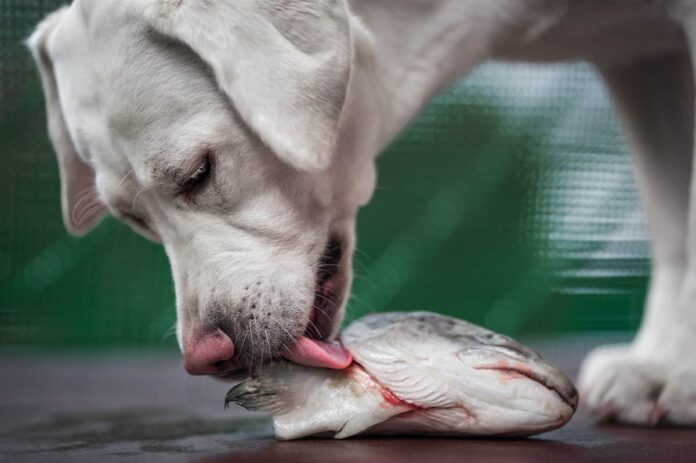Hey there, fellow pet parents! Ever caught yourself wondering if it’s okay to toss that leftover fish head to your drooling pup? Well, you’re not alone! Today, I’m gonna spill the tea on everything you need to know about feeding fish heads to your four-legged bestie.
The Quick Answer (For Those in a Hurry!)
Yes, dogs can eat fish heads, but with some important catches! They’re actually pretty nutritious, but you gotta be careful about how you prepare them and which types you feed your pup.
Why Fish Heads Could Be Your Dog’s New Favorite Treat
The Good Stuff (Nutritional Benefits)
- Omega-3 fatty acids – These bad boys are super important for your dog’s:
- Brain development
- Coat health
- Joint function
- Immune system
- Protein – Like, tons of it!
- Calcium from bones
- Vitamin D and B12
Safety First: How to Serve Fish Heads to Your Dog
The Do’s ✅
-
Always cook the fish heads thoroughly
- Kills harmful bacteria
- Makes bones softer and safer
- Reduces risk of parasites
-
Remove larger bones
- Even tho some bones are OK, better safe than sorry!
-
Start small
- Give tiny portions first
- Watch for any tummy troubles
The Don’ts ❌
-
Never serve raw fish heads
- Can contain harmful bacteria
- Might have parasites
- Raw bones are dangerous
-
Avoid these fish species:
- King mackerel
- Tuna (especially large species)
- Shark
- Swordfish(These guys can have high mercury levels)
Best Fish Heads for Your Dog
- Salmon (cooked only!)
- Sardines
- Flounder
- Cod
- Whitefish
Common Questions Pet Parents Ask
“Help! My Dog Ate a Raw Fish Head!”
Stay cool! Here’s what to do:1. Don’t panic2. Watch for these symptoms: – Vomiting – Diarrhea – Lethargy – Loss of appetite3. Call your vet if you notice anything weird
“How Often Can I Feed Fish Heads?”
Keep it moderate, fam! Once or twice a week is plenty. Think of fish heads as a treat, not a main course.
Preparing Fish Heads: A Step-by-Step Guide
-
Clean thoroughly
- Remove scales
- Wash well
- Check for hooks (if fresh-caught)
-
Cook properly
- Boil or bake until fully cooked
- No seasonings needed
- No oil or butter
-
Cool down
- Let it cool completely
- Break into manageable pieces
The Benefits of Adding Fish to Your Dog’s Diet
Physical Benefits
- Better joint health
- Shinier coat
- Improved brain function
- Stronger immune system
Mental Benefits
- New textures = mental stimulation
- Variety in diet = happy doggo
- Natural chewing satisfaction
Potential Risks and How to Avoid Them
Choking Hazards
- Always supervise your dog
- Remove larger bones
- Break into appropriate sizes
Allergic Reactions
- Start with small amounts
- Watch for:
- Scratching
- Skin irritation
- Digestive issues
Alternative Fish Options
Not ready for whole fish heads? Try these instead:* Canned sardines (in water)* Cooked fish fillets* Fish-based dog food
Real Talk: My Experience
Ngl, when I first gave my dog, Max, a fish head, I was super nervous! But following these guidelines made it a safe and enjoyable experience for both of us. He’s now a total fish head enthusiast!
Final Thoughts
Fish heads can be an awesome addition to your dog’s diet when prepared correctly. They’re like a natural multivitamin wrapped in a tasty package! Just remember:* Cook thoroughly* Remove big bones* Start small* Monitor your pup
Now you’re ready to safely introduce fish heads to your furry friend! Remember, every dog is different, so what works for one might not work for another. Always trust your gut and consult your vet if you’re unsure.
Have you tried giving your dog fish heads? Drop a comment below and share your experience! And don’t forget to hit that subscribe button for more pawsome pet advice!
Disclaimer: While this guide is based on research and experience, always consult your veterinarian before making significant changes to your dog’s diet, especially if they have existing health conditions or dietary restrictions.











![Can Dogs Have Surimi? The Truth About Feeding Imitation Crab to Your Furry Friend Can Dogs Eat Imitation Crab? [MUST KNOW FACTS!!]](https://petlikeboss.com/wp-content/uploads/2024/11/Can-Dogs-Eat-Sushi-Rice-2-100x70.jpg)
